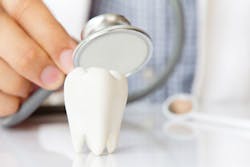A system for the link? The oral-systemic link is spilling over into multiple health-care settings
By Kathryn Kamish Gilliam, RDH, BA
As more consumers learn how their oral health affects their overall health, it is imperative that dental professionals recognize their critical role in performing periodontal disease risk assessment and intervention to potentially prevent negative systemic sequelae and improve the oral and overall health of their patients. Approximately 70% of the US population visits a dental office at least once a year, according to data from the Centers for Disease Control and Prevention (CDC).1 This is significantly more often than people visit their physicians. The responsibility, therefore, lies with dental professionals to protect not only the oral health of their patients, but their systemic health as well.
According to the 2000 US Surgeon General’s report, Oral Health in America, oral examination can reveal signs and symptoms of more than 90% of the systemic diseases people experience.2 Identifying these early signs and symptoms may facilitate early diagnosis and treatment, potentially resulting in improved systemic health.
The association between periodontal disease and systemic disease is now widely accepted, and the term “oral-systemic link” refers to the connection between the two. Periodontal disease has been shown to result in inflammation in parts of the body beyond the oral cavity. It is this inflammation and the causative periodontal pathogens that have been implicated as contributing factors, through a variety of pathways, in many systemic diseases and conditions.
In all of its stages, as periodontal disease progresses from gingivitis to periodontitis, periodontal disease has the potential to affect the overall health of the host. Inflammation spreads throughout the body to distant points from the oral cavity. The systemic response is triggered by pro-inflammatory cytokines - particularly interleukin-1 (IL-1), interleukin-6 (IL-6), and tumor necrosis factor-alpha (TNF-α) - which are released in the circulation.3 During an inflammatory response, immune cells are recruited to the site of infection, which inadvertently increases transmission and spread of the pathogen.4
‘Most abundant’ inflammation
In fact, periodontal disease has been identified as the body’s most abundant source of chronic low-grade inflammation. This causes a decrease in the body’s immune response, contributes to the total inflammatory burden of the body, and, eventually causes irreversible damage to the immune system.5
Scientific findings have pointed to a causal or bidirectional relationship between periodontal disease and certain systemic diseases or conditions. The ongoing inflammation associated with an infected periodontium may serve as a reservoir of gram-negative bacteria, bacterial by-products, antigens, cytokines, and other pro-inflammatory mediators that can interact with many organ systems, contributing to disease conditions in other areas of the body.6
Periodontal disease may compromise the immune system, elevating the risk for systemic conditions. Infectious and opportunistic microbes responsible for periodontal infection may bring this bioburden to the rest of the body. These microbes can also release metabolic by-products that elicit an inflammatory response.7
Periodontal infections may increase blood viscosity as well as coagulation ability.8 Elevated levels of leukocytes and fibrinogen are found with plaque and gingival inflammation. Some gram-negative periodontal pathogens bind to blood platelets, resulting in aggregation on heart valves. Research also demonstrates that the periodontal pathogen Porphyromonas gingivalis (P. gingivalis) activates platelets, resulting in the formation of platelet/white blood cell (WBC) aggregates that support WBC activation, adhesion, and transmigration through the arterial endothelium, which is critical for atherosclerotic development.8
The link to cardiovascular disease has been well established. In the arterial wall, atherosclerotic plaques are created by the macrophages engulfing LDL cholesterol particles. When observed through a microscope, they appear foamy and are referred to as “foam cells.” Foam cells, cellular debris, and smooth muscle cells aggregate in the arterial wall. This buildup, combined with ongoing inflammation, can expand the arterial wall and decrease the size of the lumen, restricting blood flow.9 Sometimes the thin tissue layer that covers the atherosclerotic plaque ruptures, causing clots to form. This often triggers a heart attack, stroke, or peripheral vascular event, depending on the artery involved.
It has been proven by Bale, Doneen, and Vigerust that P. gingivalis is causal for cardiovascular disease.10
It is estimated that between 500 and 700 species of bacteria exist in the oral cavity.11 The nutrient-rich and oxygen-poor environment of the gingival sulcus provides ideal conditions for the growth of oral bacteria. These bacteria are extremely difficult to eradicate, because they form multilayered biofilms where they create channels for food supply and waste disposal. The most virulent bacteria are in the deepest layers of the biofilm.12 These bacteria appear to be the microbes that cause the most damage to the supporting structures of the teeth. When this biofilm of pathogenic invaders is undisturbed, either by professional prophylaxis or thorough subgingival plaque removal, the immune system attacks the bacteria with neutrophils. The first signs of inflammation then appear clinically, manifesting as redness and swelling.13
If the neutrophils are able to limit the bacterial assault, the result is gingivitis, a state of low-level infection. If the bacteria are able to advance into the gum tissues despite the presence of neutrophils, the immune system steps up its response by releasing macrophages - large white blood cells that phagocytize the bacteria and the dead and dying neutrophils along with any other cellular debris found in the infected sulcus and surrounding tissues.13 The macrophages secrete fatty acids and IL-1, a primary inflammatory and immune response regulator, as well as TNF-α, a protein that increases inflammation. If progression from gingivitis to periodontitis occurs, inflammation destroys the ligaments that anchor the teeth to the bone, and osteoclastic activity, driven by the patient’s immunoinflammatory response, causes alveolar bone loss. The patient now has periodontitis, which potentially results in mobility and eventually tooth loss.13
Pathogenic bacteria initiate periodontal disease; however, most of the damage to the periodontium occurs as a result of the inflammatory response to the bacterial attack.14 People with periodontal disease are 40% more likely to have other chronic health conditions than those with healthy gums.13 Chronic, uncontrolled inflammation, with pro-inflammatory mediators leaking out of the gums and into the bloodstream - adding to the total inflammatory burden - is being studied as a likely explanation for the link between periodontal disease and systemic illnesses. Another likely explanation is the microbial ecosystem in the mouth, and the ability of those virulent pathogens to travel through the bloodstream throughout the body. Researchers have found highly invasive oral pathogens in arterial plaque, synovial fluid, and intracranial aneurysms, among others.15
According to a 2014 study published in Frontiers in Microbiology, it is becoming evident that low-grade subclinical infections may be an underlying cause of many chronic inflammatory diseases and may contribute to secondary systemic diseases.16 Chronic low-grade infections, such as gingivitis, may be associated with an increased distribution of pathogens throughout the body, which can lead to potentially devastating systemic health conditions.7 The traditional lack of concern about gingivitis in patients - because it’s “just a little inflammation” - could potentially lead to serious systemic consequences.
In many cases, the burden of proof of a causal relationship between periodontal disease and systemic disease is not yet met. Research is ongoing to determine if periodontal disease is a major or minor component in a variety of systemic diseases. Currently, periodontal disease has several relationships to systemic disease:
- An association means that a patient with periodontal disease could be at increased risk for systemic disease, but that periodontal disease does not cause the systemic disease.
- A causal relationship means that periodontal disease caused or initiated the systemic disease.
- A bidirectional relationship means that periodontal disease contributes to or causes the systemic disease and the systemic disease contributes to or causes the periodontal disease.
The Medical/ Dental Gap
Traditionally, the fields of medicine and dentistry have been separate. But as the link between oral and systemic diseases continues to be researched and verified, this gap is beginning to narrow, and medical and dental professionals are realizing a need to work together to treat the whole patient.
According to data from the CDC, 70% of the population visits a dental office annually, leaving 30% who do not regularly see a dentist.1 A certain percentage of those people may see a physician; therefore, education regarding periodontal disease and its systemic implications is imperative for medical professionals. Just as oral health professionals need to look beyond the oral cavity when they diagnose periodontal disease, there is a need for medical doctors to look at more than tonsils when they examine a patient’s mouth. When physicians note uncontrolled blood sugar levels on lab results, for example, they should not only prescribe medication, dietary information, and exercise guidelines, but they should also refer those patients to a dentist for evaluation and treatment of periodontal disease.
Routine collaboration between dental health-care providers and physicians to detect and treat systemic conditions relating to periodontal disease is an idea that is gaining momentum. In 2010, the American Dental Hygienists’ Association stated that dental hygienists are an integral part of the health-care team as they perform assessments of periodontal health and determine protocols for treatment of periodontal disease and management of patients’ home-care routines.17
Dental hygienists work in conjunction with dentists and interface with medical professionals of various disciplines. Interprofessional collaboration between health-care providers would improve outcomes, as all aspects of patients’ health would be addressed. Studies have shown, for example, that it is difficult to control blood sugar in the presence of periodontal disease. Therefore, to medicate a patient without controlling periodontal pathogens would only address part of the patient’s health needs. The new paradigm is to treat the whole patient in order to achieve better health.
Turning awareness into action
Despite the fact that many respected dental and medical opinion leaders encourage dental practitioners to treat periodontal disease with an increasing focus on total body wellness, this philosophy has not yet been incorporated into the majority of dental practices.18
Dental health-care providers pointed to a variety of barriers to implementing research evidence into dental practice:
- Lack of awareness of available research
- Time constraints
- Insufficient authority to change practice protocols
- Inadequate skills in critical appraisal
- Lack of support
- Patient’s objection to fees
- Lack of reimbursement from third-party providers
- Concern over legal risk
- Concern about perception by the dental board as the unauthorized practice of medicine
According to this study, other factors that influence dental hygiene care are the hygienists’ various philosophies of practice, their own expectations of professionalism, and the expectations of their employers and patients. The answer to overcoming these barriers is continuing education in the form of professional courses and in-office coaching and training by experienced clinicians.
It is compelling that physician Charles Whitney, MD, wrote: “Periodontal inflammation and infection is a medical disease of the mouth that physicians cannot treat.”19 Dental professionals are the leaders in treating this “medical disease of the mouth.” In order to do so, dentists and dental hygienists must expand their practice to include protocols beyond the traditional treatment for periodontal disease.
There is a growing movement among individual practitioners, as well as professional organizations, for a revolution in health care. Collaboration among physicians, dental hygienists, and dentists is critical, and the time has come to incorporate the systemic health needs of the dental patient into every dental care appointment. RDH
Kathryn Kamish Gilliam, RDH, BA, is a practicing clinician, author, speaker, consultant, and founder of PerioLinks LLC. She empowers dental professionals to elevate their standard of care with protocols based on sound scientific principles. A faculty member and clinical coach for Productive Dentist Academy and Benco Dental Practice Management, Kathryn guides dental professionals to become oral health-care practitioners who powerfully impact the lives and health of their patients. The results are healthier patients, higher production, and reenergized teams. She likes to say, “We’re not just cleaning teeth; we’re saving lives.” Kathryn can be reached at [email protected] or (832) 264-8343.
References
1. Eke PI, Dye BA, Wei L, et al. Prevalence of periodontitis in adults in the United States: 2009 and 2010. J Dent Res. 2012;91(10):914-920.
2. US Department of Health and Human Services. Oral Health in America: A Report of the Surgeon General - Executive Summary. Rockville, MD: US Department of Health and Human Services, National Institute of Dental and Craniofacial Research, National Institutes of Health, 2000.
3. Ashley NT, Weil ZM, Nelson, RJ. Inflammation: Mechanisms, costs, and natural variation. Annu Rev Ecol Evol Syst. 2012;43:385-406. doi: 10.1146/annurev-ecolsys-040212-092530.
4. Sorci G, Faivre B. 2009. Inflammation and oxidative stress in vertebrate host-parasite systems. Philos Trans R Soc Lond B Biol Sci. 2009;364(1513):71-83. doi: 10.1098/rstb.2008.0151.
5. El-Shinnawi U, Soory M. Associations between periodontitis and systemic inflammatory diseases: response to treatment. Recent Pat Endocr Metab Immune Drug Discov. 2013;7(3):169-188.
6. Ashley NT, Weil ZM, Nelson, RJ. Inflammation: Mechanisms, costs, and natural variation. Annu Rev Ecol Evol Syst. 2012;43:385-406. doi: 10.1146/annurev-ecolsys-040212-092530.
7. Kim J, Amar S. Periodontal disease and systemic conditions: a bidirectional relationship. Odontology. 2006;94(1):10-21.
8. Fifer KM, Qadir S, Subramanian S, et al. Positron emission tomography measurement of periodontal 18F-fluorodeoxyglucose uptake is associated with histologically determined carotid plaque inflammation. J Am Coll Cardiol. 2011;57(8):971-976. doi: 10.1016/j.jacc.2010.09.056.
9. Yu XH, Fu YC, Zhang DW, Yin K, Tang CK. Foam cells in atherosclerosis. Clin Chim Acta. 2013;424:245-252. doi: 10.1016/j.cca.2013.06.006.
10. Bale BF, Doneen AL, Vigerust DJ. High-risk periodontal pathogens contribute to the pathogenesis of atherosclerosis. Postgrad Med J. Published online first: November 29, 2016. doi:10.1136/postgradmedj- 2016-134279. 2016;0:1-6.
11. Bik EM, Long CD, Armitage GC, et al. Bacterial diversity in the oral cavity of 10 healthy individuals. ISME J. 2010;4(8):962-974. doi: 10.1038/ismej.2010.30.
12. Guthmiller JM, Novak KF. Periodontal diseases. In: Brogden KA, Guthmiller JM, eds. Polymicrobial Diseases. Washington, DC: ASM Press; 2002: Chapter 8. Available from: http://www.ncbi.nlm.nih.gov/books/NBK2496/.
13. Gurenlian JR. Inflammation: the relationship between oral health and systemic disease. Access. 2006;20(Suppl).
14. Ross PE. Invaders and the body’s defenses: Gum disease illustrates how local infections may have systemic consequences. In: Scientific American Presents Oral and Whole Body Health. New York, NY; 2006:6-11. http://chfs.ky.gov/NR/rdonlyres/2010A378-30BE-4148-888A-7FCF293B51BE/0/OralHealthOsteoporosisSeepg3637.pdf. Accessed August 24, 2017.
15. Han YW, Wang X. Mobile microbiome: oral bacteria in extra-oral infections and inflammation. J Dent Res. 2013;92(6):485-491. doi: 10.1177/0022034513487559.
16. Miles B, Abdel-Ghaffar KA, Gamal AY, Baban B, Cutler CW. Blood dendritic cells: ‘canary in the coal mine’ to predict chronic inflammatory disease? Front Microbiol. 2014;5:6. doi: 10.3389/fmicb.2014.00006.
17. American Dental Hygienists’ Association Policy Manual. American Dental Hygienists’ Association. Chicago, IL: American Dental Hygienists’ Association; 2016. www.adha.org/resources-docs/7614_Policy_Manual.pdf. Published 2016. Accessed August 24, 2017.
18. Bell KP, Phillips C, Paquette DW, Offenbacher S, Wilder RS. Incorporating oral-systemic evidence into patient care: practice behaviors and barriers of North Carolina dental hygienists. J Dent Hyg. 2011;85(2):99-113. 30.
19. Whitney C. It is time to bridge the cosmetic-systemic gap. J Cosmetic Dent. 2014;30(2):88-89/144.


